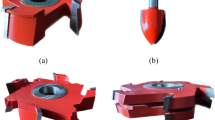Abstract
In order to understand the shaping that results from a particular machining technique, the cross section of the cut layer must be determined. A method is proposed for calculating the parameters of the cutlayer cross section in oblique single-edge boring by a radial cutter. Formulas for the thickness and width of the cut layer are based on the main cutting parameters: the supply, the cutting depth, the diameter of the insert, and the diameter of the hole produced. The proposed calculations may be used in the design of the cutting tool and the machining process.
Similar content being viewed by others
References
Denkena, B. and Biermann, D., Cutting edge geometry, CIRP Ann., 2014, vol. 63, no. 2, pp. 631–653.
Granovskii, G.I., Kinematika rezaniya (Kinematics of Cutting), Moscow: Mashgiz, 1948.
Petrushin, S.I. and Filippov, A.V., Analysis of the geometry of oblique sharpening of single-edge tools, Obrab. Met., Tekhnol., Oborud., Instrum., 2013, no. 2, pp. 8–14.
Filippov, A.V., Cut-layer cross section in oblique turning by a single-edge tool, Russ Eng. Res., 2014, vol. 34, no. 11, pp. 718–721.
Filippov, A.V., Cut-layer cross section in oblique turning by a single-edge tool with a curved front surface, Russ. Eng. Res., 2015, vol. 35, no. 5, pp. 381–384.
Filippov, A.V., Cut-layer cross section in oblique turning by a single-edge tool with a curved rear surface, Russ. Eng. Res., 2015, vol. 35, no. 5, pp. 385–388.
Filippov, A.V. and Filippova, E.O., Determination of cutting forces in oblique cutting, Appl. Mech. Mater., 2015, vol. 756, pp. 659–664.
Filippov, A.V., Geometric simulation of oblique turning by a single-edge tool with a curved front surface, Trudy VII mezhdunarodnoi nauch.-tekhn. konferentsii “Sovremennye problemy mashinostroeniya” (Proc. VII Int. Sci.-Tech. Conf. “Modern Problems of Machine Engineering”), Tomsk: Tomsk. Politekh. Univ., 2013, pp. 361–364.
Filippov, A.V. and Filippova, E.O., Estimating the cutting force when skiving with a radius cutter, IOP Conf. Ser.: Mater. Sci. Eng., 2015, vol. 91, no. 012060. doi 10.1088/1757-899X/91/1/01206010.1088/1757-899X/ 91/1/012060
Filippova, E.O. and Filippov, A.V., Experimental estimation of chip shrinkage under cup-tip cutting with straight and radius cutters, IOP Conf. Ser.: Mater. Sci. Eng., 2015, vol. 91. 012061. doi 10.1088/1757-899X/91/1/01206110.1088/1757-899X/91/1/012061
Filippov, A.V. and Gorbatenko, V.V., Influence of rake angle tool on plastic deformation in chip formation when cutting, Appl. Mech. Mater., 2014, vol. 682, pp. 525–529.
Filippov, A.V. and Proskokov, A.V., Analysis of chip forming in metal cutting by digital correlation speckleinterferometry, Vestn. Mosk. Gos. Tekhnol. Univ., Stankin, 2014, no. 2, pp. 100–113.
Filippov, A.V. and Filippova, E.O., Experimental study of chip shrinkage for radius rear surface turning tools, Izv. Vyssh. Uchebn. Zaved., Mashinostr., 2015, no. 6, pp. 48–53.
Zaitsev, K.V., et al., Ultrasonic plastic deformation of steels, IOP Conf. Ser.: Mater. Sci. Eng., 2015, vol. 91, no. 012056. doi 10.1088/1757-899X/91/1/01205610.1088/ 1757-899X/91/1/012056
Alferova, E.A., Lychagin, D.V., and Chernyakov, A., Research of stress field distribution in FCC-single crystal samples in compression, Appl. Mech. Mater., 2014, vol. 682, pp. 485–490.
Klimenko, S.A. and Manokhin, A.S., Hard turning of shaving type, Sverkhtverd. Mater., 2009, no. 1, pp. 58–74.
Raphael, G. and Stone, B.J., Boring with a process similar to skiving, CIRP Ann., 1990, vol. 39, no. 1, pp. 425–428.
Stone, B.J., Bonikowski, E.J., Chapple, D.J., and De Barr, A.E., The skiving of ball-bearing tracks, CIRP Ann., 1980, vol. 29, no. 1, pp. 275–280.
Nee, A.Y.C. and Venkatesh, V.C., Form accuracy of tangentially skived workpieces, CIRP Ann., 1985, vol. 34, no. 1, pp. 121–124.
Bobrov, V.F., Vliyanie ugla naklony glavnoi rezhushchei kromki instrumenta na protsess rezaniya metallov (Influence of the Inclination of the Tool’s Primary Cutting Edge on Metal Cutting), Moscow: Mashgiz, 1962.
Grzesik, W., A real picture of plastic deformation concentrated in the chip produced by continuous straightedged oblique cutting, Int. J. Mach. Tools Manuf., 1991, vol. 31, no. 3, pp. 329–344.
Grzesik, W. and Zak, K., Investigations of surface texture produced by oblique machining of different workpiece materials, Arch. Mater. Sci. Eng., 2011, no. 52, pp. 46–53.
Author information
Authors and Affiliations
Corresponding author
Additional information
Original Russian Text © A.V. Filippov, N.N. Shamarin, O.A. Podgornykh, P.A. Chazov, 2016, published in STIN, 2016, No. 10, pp. 33–37.
About this article
Cite this article
Filippov, A.V., Shamarin, N.N., Podgornykh, O.A. et al. Cross section of the cut layer in oblique single-edge boring by a radial cutter. Russ. Engin. Res. 37, 367–371 (2017). https://doi.org/10.3103/S1068798X17040098
Published:
Issue Date:
DOI: https://doi.org/10.3103/S1068798X17040098




